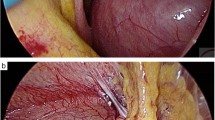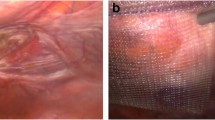Abstract
Purpose
Patients with large incisional hernias have significant morbidity and their management is a challenge for the surgical team because of the large abdominal wall involvement. The choice of surgical technique is still controversial. The purpose of this study is to analyze the predictive factors for recurrence after intraperitoneal mesh repair in patients with large incisional hernias.
Methods
A retrospective cohort observational study with a prospectively collected database was performed in the Hospital Clinico San Carlos (Madrid, Spain). All consecutive patients operated on from January 2009 to December 2014 with incisional hernia of 10 or more centimeters in its transverse diameter were included. An intraperitoneal repair with a composite mesh fixed with discontinuous absorbable suture and fibrin sealant was performed. Demographic data, comorbidities, and early and long term outcomes were analyzed. The primary outcome was the presence of recurrence.
Results
One hundred and twenty patients were included. Mean age was 63.3 years (SD 12.9) and sex ratio was 1.4:1. Seventy-two patients (60%) were ASA III–IV. Forty-five patients (37.5%) had recurrent ventral hernias. Mean defect size was 14.7 cm (SD 3.21) of width. Overall postoperative morbidity rate was 25%. Median hospital stay was 6 days (IQR 4–8). Recurrence rate was 8.3%, after a median follow-up of 16 months (IQR 10–25). Multivariate analysis showed significant association between ASA III–IV, use of Composix Kugel™ mesh, superficial surgical site infection, and the presence of recurrence.
Conclusions
The recurrence rate after intraperitoneal mesh repair in patients with large incisional hernias might be associated with ASA III–IV, use of Composix Kugel™ mesh, and superficial surgical site infection.

Similar content being viewed by others
References
Millbourn D, Cengiz Y, Israelsson LA (2009) Effect of stitch length on wound complications after closure of midline incisions: a randomized controlled trial. Arch Surg 144:1056–1059. doi:10.1001/archsurg.2009.189
Muysoms FE, Miserez M, Berrevoet F et al (2009) Classification of primary and incisional abdominal wall hernias. Hernia 13:407–414. doi:10.1007/s10029-009-0518-x
Helgstrand F, Rosenberg J, Kehlet H et al (2013) Nationwide prospective study of outcomes after elective incisional hernia repair. J Am Coll Surg 216:217–228. doi:10.1016/j.jamcollsurg.2012.10.013
Eriksson A, Rosenberg J, Bisgaard T (2014) Surgical treatment for giant incisional hernia: a qualitative systematic review. Hernia 18:31–38. doi:10.1007/s10029-013-1066-y
Den Hartog D, Dur AH, Tuinebreijer WE, Kreis RW (2008) Open surgical procedures for incisional hernias. Cochrane Database Syst Rev 16:CD006438. doi:10.1002/14651858
Muysoms F, Campanelli G, Champault GG et al (2012) EuraHS: the development of an international online platform for registration and outcome measurement of ventral abdominal wall hernia repair. Hernia 16:239–250. doi:10.1007/s10029-012-0912-7
Horan TC, Gaynes RP, Martone WJ, Jarvis WR, Emori TG (1992) CDC definitions of nosocomial surgical site infections, 1992: a modification of CDC definitions of surgical wound infections. Infect Control Hosp Epidemiol 13:606–608. doi:10.2307/30148464
Dindo D, Demartines N, Clavien PA (2004) Classification of surgical complications: a new proposal with evaluation in a cohort of 6336 patients and results of a survey. Ann Surg 240:205–213. doi:10.1097/01.sla.0000133083.54934.ae
Dietz UA, Winkler MS, Härtel RW et al (2014) Importance of recurrence rating, morphology, hernial gap size, and risk factors in ventral and incisional hernia classification. Hernia 18:19–30. doi:10.1007/s10029-012-0999-x
Collins GS, Reitsma JB, Altman DG, Moons KG (2015) Transparent Reporting of a multivariate prediction model for Individual prognosis Or Diagnosis (TRIPOD). Ann Intern Med 162:755–763. doi:10.7326/L15-5093-2
Burger JW, Lange JF, Halm JA, Kleinrensink GJ, Jeekel H (2005) Incisional hernia: early complication of abdominal surgery. World J Surg 29:1608–1613. doi:10.1007/s00268-005-7929-3
Baccari P, Nifosi J, Ghirardelli L et al (2013) Short- and mid-term outcome after laparoscopic repair of large incisional hernia. Hernia 17:567–572. doi:10.1007/s10029-012-1026-y
Moreno-Egea A, Carrillo A, Aguayo JL (2012) Is the outcome of laparoscopic incisional hernia repair affected by defect size? A prospective study. Am J Surg 203:87–94. doi:10.1016/j.amjsurg.2010.11.017
Timmermans L, de Goede B, van Dijk SM, Kleinrensink GJ, Jeekel J, Lange JF (2014) Meta-analysis of sublay versus onlay mesh repair in incisional hernia surgery. Am J Surg 207:980–988. doi:10.1016/j.amjsurg.2013.08.030
Afifi RY (2005) A prospective study between two different techniques for the repair of a large recurrent ventral hernia: a double mesh intraperitoneal repair versus onlay mesh repair. Hernia 9:310–315. doi:10.1007/s10029-005-0017-7
Deerenberg EB, Timmermans L, Hogerzeil DP et al (2015) A systematic review of the surgical treatment of large incisional hernia. Hernia 19:89–101. doi:10.1007/s10029-014-1321-x
Ammaturo C, Bassi G (2004) Surgical treatment of large incisional hernias with an intraperitoneal Parietex Composite mesh: our preliminary experience on 26 cases. Hernia 8:242–246. doi:10.1007/s10029-004-0223-8
Fortelny RH, Petter-Puchner AH, Glaser KS, Redl H (2012) Use of fibrin sealant (Tisseel/Tissucol) in hernia repair: a systematic review. Surg Endosc 26:1803–1812. doi:10.1007/s00464-012-2156-0
Eriksen JR, Bech JI, Linnemann D, Rosenberg J (2008) Laparoscopic intraperitoneal mesh fixation with fibrin sealant (Tisseel) vs. titanium tacks: a randomised controlled experimental study in pigs. Hernia 12:483–491. doi:10.1007/s10029-008-0375-z
Hanna EM, Byrd JF, Moskowitz M, Mann JW, Stockamp KT et al (2014) Outcomes of a prospective multi-center trial of a second-generation composite mesh for open ventral hernia repair. Hernia 18:81–89. doi:10.1007/s10029
Lannitti DA, Hope WW, Norton HJ et al (2008) Technique and outcomes of abdominal incisional hernia repair using a synthetic composite mesh: a report of 455 cases. J Am Coll Surg 206:83–88. doi:10.1016/j.jamcollsurg.2007.07.030
Kunishige T, Takayama T, Matumoto S et al (2013) A defect of the abdominal wall with intestinal fistulas after the repair of incisional hernia using Composix Kugel Patch. Int J Surg Case Rep 4(793):797. doi:10.1016/j.ijscr.2013.05.014
Williams RF, Martin DF, Mulrooney MT, Voeller GR (2008) Intraperitoneal modification of the Rives–Stoppa repair for large incisional hernias. Hernia 12:141–145. doi:10.1007/s10029-007-0300-x
Iqbal CW, Pham TH, Joseph A et al (2007) Long-term outcome of 254 complex incisional hernia repairs using the modified Rives–Stoppa technique. World J Surg 31:2398–2404. doi:10.1007/s00268-007-9260-7
Rios A, Rodriguez JM, Munitiz V, Alcaraz P, Pérez D, Parrilla P (2001) Factors that affect recurrence after incisional herniorrhaphy with prosthetic material. Eur J Surg 167:855–859. doi:10.1080/11024150152717706
Anthony T, Bergen PC, Kim LT et al (2000) Factors affecting recurrence following incisional herniorrhaphy. World J Surg 24:95–101. doi:10.1007/s002689910018
Dietz UA, Hamelmann W, Winkler MS et al (2007) An alternative classification of incisional hernias enlisting morphology, body type and risk factors in the assessment of prognosis and tailoring of surgical technique. J Plast Reconstr Aesthet Surg 60:383–388. doi:10.1016/j.bjps.2006.10.010
Author information
Authors and Affiliations
Corresponding author
Ethics declarations
Conflict of interest
Lasses Martínez B, Peña Soria MJ, Cabeza Gómez JJ, Jiménez Valladolid D, Flores Gamarra M, Fernández Pérez C, Torres García A and Delgado Lillo I, declare that they have no conflict of interest.
Ethical standards
All procedures performed in studies involving human participants were in accordance with the ethical standards of the institutional and/or national research committee and with the 1964 Helsinki Declaration and its later amendments or comparable ethical standards.
Informed consent
For this type of study formal consent is not required.
Rights and permissions
About this article
Cite this article
Lasses Martínez, B., Peña Soria, M.J., Cabeza Gómez, J.J. et al. Surgical treatment of large incisional hernias with intraperitoneal composite mesh: a cohort study. Hernia 21, 253–260 (2017). https://doi.org/10.1007/s10029-016-1557-8
Received:
Accepted:
Published:
Issue Date:
DOI: https://doi.org/10.1007/s10029-016-1557-8




